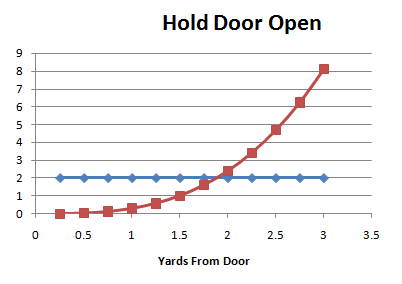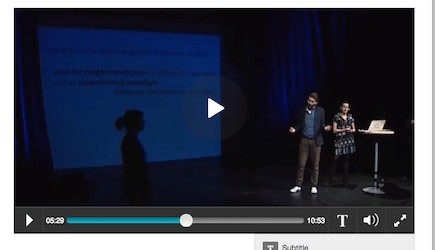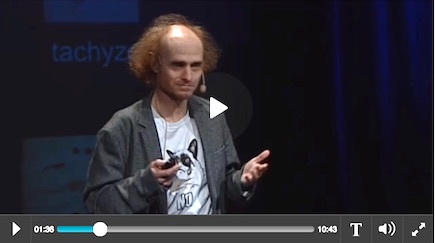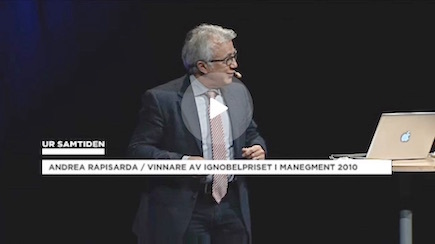Marc Abrahams's Blog, page 327
May 28, 2015
Sherpherd physics: Capturing a skittish lamb, using statistical physics
A trio of theoretical physicists have recently used ideas from statistical mechanics and probability theory to try to develop an optimal strategy for capturing a skittish lamb near a precipice.
The situation that they model is an idealization of “the capture of a diffusing, but skittish lamb, with an approaching shepherd on the left and a precipice on the right.” They approached this problem by examining first-passage probabilities, which describe the first time of some event (e.g., a lamb falling off of a cliff) occurring. The physicists summarized their strategy as follows:
In particular, the probability to capture the lamb is maximized when the shepherd moves at a non-zero optimal speed if the initial lamb position and the ratio between the two boundary speeds satisfy certain conditions.
Here’s further detail from the study:
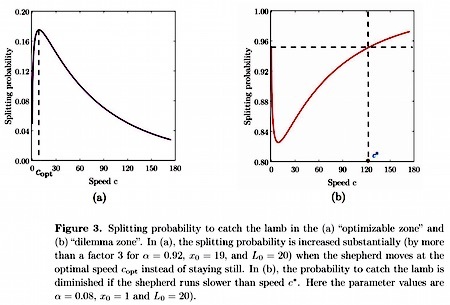
One of the physicists, Sid Redner, works at the Santa Fe Institute, so perhaps the next problem he’ll attempt is to design a strategy to help Wile E. Coyote catch the Roadrunner.
BONUS: Redner on the question: In a pro basketball game, when is a lead safe?

May 27, 2015
Podcast #13: Telephones for animals
The California inventor (and Taser Corporation advisor) of a telephone for animals and a cell phone that reaches out and shocks bad guys, borborygmi (the sounds made by your intestines), the phrase “I don’t know”, and other things turn up in this week’s Improbable Research podcast.
LISTEN on Play.it or iTunes (or DOWNLOAD it, and listen later).
SUBSCRIBE on Play.it or iTunes, to get a new episode every week, free.
[NEWS: Soon, the podcast will also be available on Spotify.]
[cbs-clip-player content_id=59056517 size=small station=121]
This week, Marc Abrahams tells about:
 Telephones for animals.
(“Domestic animal telephone“, US patent granted to Mark W. Kroll, # 7654230, granted February 2, 2010. Featuring dramatic readings by Melissa Franklin.)
Telephones for animals.
(“Domestic animal telephone“, US patent granted to Mark W. Kroll, # 7654230, granted February 2, 2010. Featuring dramatic readings by Melissa Franklin.)Self-defense cell phone. (“Self defense cell phone with shocking circuitry,” US patent US7986965, issues July 26, 2011 to Chase R. Kroll and Mark W. Kroll. / “Essentials of low-power electrocution: Established and speculated mechanisms,” Mark W. Kroll, R. M. Fish, D. Lakkireddy, R. M. Luceri, and D. Panescu, in Engineering in Medicine and Biology Society (EMBC), 2012 Annual International Conference of the IEEE, pp. 5734-5740. IEEE, 2012. / TASER International, Inc. / Featuring dramatic readings by Daniel Rosenberg.)
Improbable Medical Review. (“Accidental Mobile Phone Card Ingestion,” Sudesh Dixit, Jayanand Mekwan, and Nigel F. Brayley, Emergency Medicine Journal, vol. 24, 2007, p. 142 / “Ingested Foreign Bodies and Societal Wealth: Three-Year Observational Study of Swallowed Coins,” P.G. Firth, H. Zheng, and J.A. Biller, BMJ, vol. 341, 2010. / “Reversing Brow Lifts,” M.J. Yaremchuk, N. O’Sullivan, and F. Benslimane, Aesthetic Surgery Journal, vol. 27, no. 4, July–August 2007, pp. 367–75. Featuring dramatic readings by Maggie Lettvin.)
What Your Gut Says, Psychoanalytically. (“New Observations on Body Organ Language,” Christian Muller, Psychotherapy and Psychosomics, vol. 42, nos. 1–4, 1984, pp. 124–6 / “Borborygmi as Markers of Psychic Work During the Analytic Session: A Contribution to Freud’s Experience of Satisfaction and to Bion’s Idea About the Digestive Model for the Thinking Apparatus,” International Journal of Psycho-Analysis, vol. 71, 1990, p. 641–59. / “The Emergence of Thinking: Bion as the Link Between Freud and the Neurosciences,” Guy Da Silva, in M. Grignon (Ed.) Psychoanalysis and the Zest for Living: Reflections and Psychoanalytic Writings in Memory of W.C.M. Scott, ESF Publishers, Binghamton, NY, 1998. / “Le Modèle Alimentaire dans la Théorie de la Pensée de Bion: Suivi d’une Application de ce Modèle dans l’Analyse d’un Patient,” Guy Da Silva, Symposium of the Société Psychanalytique de Montréal, Spring 1992. Featuring dramatic readings by Jean Berko Gleason.) BONUS: In this video, a woman records her borborygmi:
Improbable Research Review. (“Prehension of Half-Full and Half-Empty Glasses: Time and History Effects on Multi-Digit Coordination” Yao Sun, Vladimir M. Zatsiorsky, and Mark L. Latash, Experimental Brain Research, vol. 209, 2011, pp. 571–85. / “A Corpus Comparison of the Use of I Don’t Know by British and New Zealand Speakers,” Lynn E. Grant, Journal of Pragmatics, vol. 42, 2010, pp. 2282–96. / “The Moss from the Tyrolean Iceman’s Colon,” James H. Dickson, Journal of Bryology, vol. 19, no. 3, 1997, pp. 449–51. Featuring dramatic readings by Melissa Franklin.)
The mysterious John Schedler perhaps did the sound engineering this week.
The Improbable Research podcast is all about research that makes people LAUGH, then THINK — real research, about anything and everything, from everywhere —research that may be good or bad, important or trivial, valuable or worthless. CBS distributes it, both on the new CBS Play.it web site, and on iTunes (and soon, also on Spotify).

May 26, 2015
People-calculating: open doors and closed doors
 Whether one person holds a door open for another is not simply a question of etiquette, says a study by Joseph P Santamaria and David A Rosenbaum [pictured here] of Pennsylvania State University. No, they say. Nothing simple about it.
Whether one person holds a door open for another is not simply a question of etiquette, says a study by Joseph P Santamaria and David A Rosenbaum [pictured here] of Pennsylvania State University. No, they say. Nothing simple about it.
Santamaria and Rosenbaum worked to pursue the answer through a tangle of belief, logic, probability, perception and calculation. Their study, Etiquette and Effort: Holding Doors for Others, was published in 2011 in the journal Psychological Science. It is, one way or another, a gripping read....
—So begins the latest Improbable Research column in The Guardian.
BONUS: This graph is from an economist’s alternative take on the question:

May 25, 2015
Improbable Swedish TV: Ignobelseminarium in Stockholm
The Swedish public television network SVT filmed the Ig Nobel show at Boulevardteatern in Stockholm on March 25, 2015. Two months later, SVT broadcasted their video of that night. It is (at least for a while) available on SVT’s UR Play web site. (Many thanks to publishers Fri tanke förlag, to Boulevardteatern, and to dapper neuroscientist Gustav Nilsonne for helping arrange the event!)
Here are links to highlights from that show (click on each image to see the video).
Sabine Begall and Pascal Malkemper tell how their team, in the Czech Republic and Germany, gathered evidence that dogs, while excreting, often align their body axis with earth’s north-south magnetic field lines:
Jaroslav Flegr, of the Czech Republic, tells how he and others learned more about the question of whether it is mentally hazardous to own a cat.
Andrea Rapisarda tells how he and his colleagues in Italy discovered that, for most organizations, promotions produce the best results if people are promoted at random.
Dr. Nakamats, with perhaps the most unusual wrapup musical performance ever given anywhere, tells about his more than 3500 patents, and his upcoming final birthday party in Japan:

‘Why It’s So Hard to Understand Opera’
 If you’ve ever asked yourself why it’s so hard to understand opera, then you could turn to the work of Bertram M. Schwarzschild for explanation(s). He wrote an article on the subject which featured in the journal New Zealand Acoustics, 17(3), pp.15- 20 . (2004), entitled: ‘Why It’s So Hard to Understand Opera‘
If you’ve ever asked yourself why it’s so hard to understand opera, then you could turn to the work of Bertram M. Schwarzschild for explanation(s). He wrote an article on the subject which featured in the journal New Zealand Acoustics, 17(3), pp.15- 20 . (2004), entitled: ‘Why It’s So Hard to Understand Opera‘
“A frustrated listener might well define grand opera as musical theatre where you have a hard time making out the words even when they’re being sung in your own language.
Conceding the point, many opera houses nowadays always flash surtitles above the proscenium. Comprehension is particularly difficult in the higher reaches of the soprano register.”
Note: The article was originally published in Physics Today, March 2004, under the title “Acoustics Experiment Shows Why It’s So Hard to Make Out the Heroine’s Words at the Opera”.
BONUS: An opera that some may enjoy finding difficult to understand.

Some people prefer orange skin
Having or making your skin be orange-colored can help make some persons more attractive than other persons, to certain persons, for mating purposes, suggests this study:
 “Fruit over sunbed: Carotenoid skin colouration is found more attractive than melanin colouration,” Carmen E. Lefevre and David I. Perrett [pictured here], Quarterly Journal of Experimental Psychology, vol. 68, no. 2, 2015. (Thanks to Neil Martin for bringing this to our attention.) the authors, at Leeds University, Northumberland University, and the Unviversity of St. Andrews, UK, explain:
“Fruit over sunbed: Carotenoid skin colouration is found more attractive than melanin colouration,” Carmen E. Lefevre and David I. Perrett [pictured here], Quarterly Journal of Experimental Psychology, vol. 68, no. 2, 2015. (Thanks to Neil Martin for bringing this to our attention.) the authors, at Leeds University, Northumberland University, and the Unviversity of St. Andrews, UK, explain:
“Skin colouration appears to play a pivotal part in facial attractiveness. Skin yellowness contributes to an attractive appearance and is influenced both by dietary carotenoids and by melanin. While both increased carotenoid colouration and increased melanin colouration enhance apparent health in Caucasian faces by increasing skin yellowness, it remains unclear, firstly, whether both pigments contribute to attractiveness judgements, secondly, whether one pigment is clearly preferred over the other, and thirdly, whether these effects depend on the sex of the face….
“We show that carotenoid colouration is consistently preferred over melanin colouration when levels of colouration are matched. In addition, we find an effect of the sex of stimuli with stronger preferences for carotenoids over melanin in female compared to male faces, irrespective of the sex of the observer…. Taken together, our findings provide further support for a carotenoid-linked health-signalling system that is highly important in mate choice….
“In Western countries, tanning is popular and tanned skin is seen as attractive (Smith, Cornelissen, & Tovée, 2007), perhaps because it indicates status and wealth (ability to spend time tanning and holidaying; see Etcoff, 1999).”
BONUS (possibly unrelated): A new way to amplify narcissism

Champagne-cork-RFID, a new way to amplify narcissism
Behold Mumms’ champagne-cork-RFID narcissism amplifier. This promotional video from, by, and for champagne-maker G.H. Mumm, shows how an RFID [radio frequency identification] chip, coupled to a corked champaign bottle, can be used to trigger a spotlight and attention to shine on the restaurant table at which the bottle of champaign is being opened, thus drawing attention to the persons who are at that table:

May 24, 2015
Tips for persons applying for a job with Indian Railways
The RDSO — the Indian Railways’ Research Development and Standards Organization — offers tips for persons who will be taking their job application tests. These tips, offered by RDSO’s Psycho Technical Directorate, include two that may be obvious to some applicants:
If you wear glasses or a hearing aid, be sure to take them with you.
Do not try to copy the answers of your neighbor as his question booklet may be different from you.
The Psycho Technical Directorate has a logo that may intrigue art historians:

Hedges on the view of gardens residents
Can Hedges help define the view of gardens residents? Yes. Here is a report in which Hedges does exactly that:
“Co-operative Rehousing: The View of Portland Gardens Residents,” T.A. David and Alan Hedges, Centre for Urban and Regional Studies, University of Birmingham, 1988.
BONUS: How Hedges and Hedges trimmed the American dream about land
BONUS (possibly unrelated): A shrubbery:

May 23, 2015
How Hedges and Hedges trimmed the American dream about land
Can Hedges trim a book? Yes, yes. Here is a book trimmed by Hedges and Hedges:
Land and Imagination: The Rural Dream in America, by Philip Rosenberg (Author), Elaine Hedges (Editor), William Hedges (Editor) Hayden, 1980.
BONUS (possibly unrelated): A shrubbery:

Marc Abrahams's Blog
- Marc Abrahams's profile
- 14 followers



